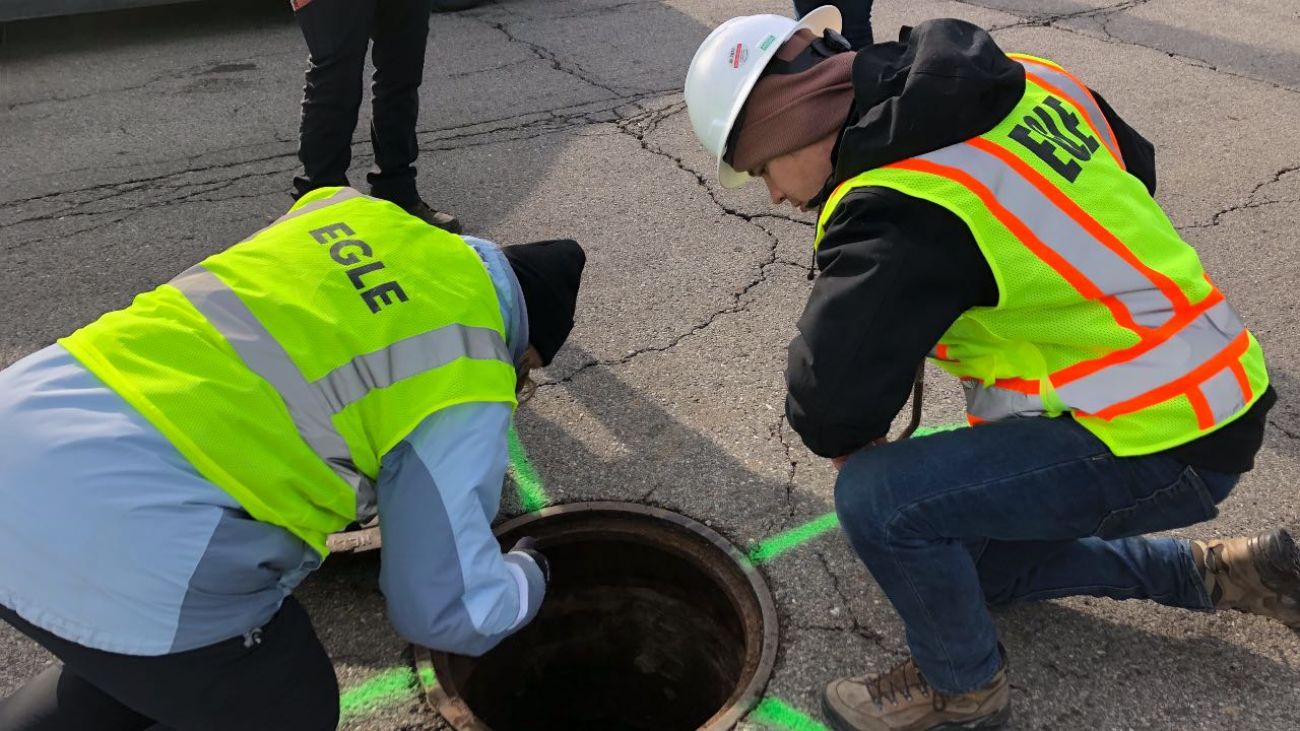Michigan’s ‘green ooze’ may be ‘tip of iceberg’ of state’s toxic sites

LANSING – The discovery of toxic PFAS chemicals at a contaminated site in Madison Heights could triple the cost of an already expensive cleanup effort, a state official told lawmakers Wednesday.
And taxpayers could get stuck with the bill to clean up the green ooze site, since it’s unclear if its imprisoned owner can pay for it.
“Is it $2 million? Is it $20 million? I don’t know, but it’s not in the hundreds of thousands. It’s in the millions,” said Tracy Kecskemeti, southeast district coordinator for the Michigan Department of Environment, Great Lakes and Energy (EGLE).
Lawmakers on the House Appropriations Committee grilled department officials during a nearly two-hour hearing at the state Capitol, questioning the state response to Electro-Plating Services and owner Gary Sayers, who was first flagged for environmental violations in the mid-1990s and is now serving a one-year prison sentence on federal charges.
- Related: Green ooze on Michigan freeway prompts calls for tougher polluter pay laws
- Opinion | After green ooze, it’s time to get serious about 'polluter pay'
Committee Chairman Shane Hernandez, R-Port Huron, held the hearing to examine whether EGLE was using its existing state funding responsibly and had properly communicated with local officials in Madison Heights, Detroit and Sanilac County, where other Sayers’ properties are under investigation.
But much of the testimony focused on the need for long-term spending to cover staggering cleanup costs at thousands of polluted sites across the state.
“It’s a hell of a lot of sites, depending on how you categorize them,” EGLE Director Liesl Clark told lawmakers. “Under our status quo budgets, we have the staff and other resources needed to monitor the sites that pose the greatest risk.”
Despite years of environmental violations at the Madison Heights site, Electro-Plating Services “did not rise to the top of the list where money and resources are available for cleanup” because it did not pose an immediate threat to drinking water, she said.
Regulators believe that’s still the case because local residents get drinking water from Lake Huron, not ground wells.

The case is a “stark demonstration” that processes “I inherited are simply not good enough,” said Clark, who took office last year. She told lawmakers the department is conducting a top-to-bottom review of those processes, as requested by Democratic Gov. Gretchen Whitmer.
Court records show Sayers took over EPS from his father in 1995 and has battled state and federal regulators since at least 1996, when Michigan first issued a letter of warning for failure to close hazardous waste containers and other issues.
The federal Environmental Protection Agency led an emergency cleanup at the Madison Heights facility in 2017. State regulators in March concluded there was little risk that remaining chemical contamination would spread from the property.
They were proved wrong on Dec. 20, when green ooze seeped onto the shoulder of Interstate 696 in Madison Heights, a neon warning that triggered national attention and criticism of state regulators. The state now believes chemical contamination spread through a previously unknown utility corridor.
Preliminary tests show the green liquid that originated from the shuttered EPS building was groundwater contaminated by industrial waste. The waste contained contaminants like cyanide, trichloroethylene and hexavalent chromium, which gained notoriety for contaminating groundwater in California and leading to a lawsuit by activist Erin Brockovich that was memorialized in a movie.
Exposure is linked to lung cancer, asthma and other ailments.
Officials last week confirmed they found elevated PFAS levels in contaminated water pooled in a basement pit at the Madison Heights facility. But the chemicals do not appear to have jeopardized drinking water intakes in Lake St. Clair, according to the state, which says 2019 testing there showed either no detections or very low PFAS levels.
State and federal regulators are sampling soil and groundwater to determine which way the contamination is flowing. They’ve installed a sump pump on the I-96 embankment and are constructing another collection point to remove temporarily groundwater.
“If we don’t address the contaminated soil under that building, this will be a perpetual state of pumping groundwater and trucking it off-site to a hazardous waste facility,” Kecskemeti said, suggesting officials may eventually need to tear down the building and excavate the site.
The discovery of PFAS will “complicate the response,” she told lawmakers, noting the so-called “forever chemicals” are commonly used in chrome plating to suppress mists. That means the regulators will need to follow special disposal procedures when removing the groundwater, likely doubling or tripling the cost.
“It’s going to get complicated, and it’s going to be expensive,” Kecskemeti said.
Michigan Attorney General Dana Nessel filed a sweeping lawsuit on Tuesday seeking to recoup PFAS cleanup costs from some of the largest chemical manufacturers in the country, including 3M and DuPont.
Environmental regulators this month inspected another property owned by Sayers in Sanilac County but did not find any hazardous materials after WXYZ-TV (Channel 7) in Detroit reported finding a metal drum with a chemical label on the site. The state is assessing ground and water samples and will use a “ground penetrating radar” to determine if Sayers buried anything there.
Officials also recently investigated a third property owned by Sayers in Detroit after firefighters found "suspicious liquids in several pits at the location," according to EGLE. Some of those liquids "resembed the green contamination" in Madison Heights, according to the state.
Sayers reported to prison this month after a 2019 plea deal in a federal criminal case. He was sentenced to one year for illegally storing hazardous waste at the Madison Heights facility and ordered to pay the Environmental Protection Agency $1.4 million in restitution for an initial emergency cleanup completed in January 2018.
He's also standing trial in a civil lawsuit filed by Madison Heights, which wants him to pay for demolishing the condemned Electro-Plating Services building.
As Bridge Magazine reported, the disaster has renewed calls for tougher "polluter pays" laws in Michigan. Democratic Gov. Gretchen Whitmer recently backed state legislation that would require owners to clean up – rather than just contain – pollution on their property.
Officials say Sayers is responsible for clean-up costs at the Madison Heights facility if he can afford it. The state last week began a new assessment that could pave the way for full Superfund status by the federal Environmental Protection Agency. That could prompt more aggressive cleanup efforts, but local officials are concerned the site still may not qualify.
As of October, Sayers’ attorneys said he had a “glimmer of hope” to pay his initial $1.4 million restitution by selling his Detroit property that is now under investigation.
State officials say he has not yet paid back the federal government, and a spokeswoman for the EPA did not immediately respond to a request for confirmation.
Madison Heights City Manager Elissa Marsh urged “full remediation” of the site including demolition of the EPS building and soil removal. Even if the site does quality for Superfund status, the cleanup could take a decade and “is not any type of solution for us,” she told lawmakers.
The green ooze is the “tip of the iceberg for environmental concerns across the state,” said state Rep. Jon Hoadley of Kalamazoo, ranking Democrat on the House Appropriations Committee. “We should stop pretending to be surprised that the health of our people and our environment is in jeopardy.”
State spending on remediation is roughly half of what it was in fiscal year 2013, according to Hoadley, who said the department has 41 fewer regulators than it did at that time.
Speaking with Bridge Magazine after the hearing, Hernandez did not commit to additional funding for environmental cleanup but noted the Legislature last year approved Whitmer’s request for $120 million in funding for clean water initiatives.
The state had relied on bonding to clean up polluted “orphaned sites” that lack clear ownership until last year, when GOP former Gov. Rick Snyder persuaded legislators to put $69 million into a permanent “Renew Michigan Fund” for toxic site cleanup, waste management and recycling.
“Obviously we’re going to monitor this particular situation,” Hernandez said of the Sayers’ properties in Madison Heights, Detroit and Sanilac County. “I mean, it has risen to another level. I think it’s important though to point out that the Legislature has already taken the initiative on cleanup in Michigan.”
Michigan Environment Watch
Michigan Environment Watch examines how public policy, industry, and other factors interact with the state’s trove of natural resources.
- See full coverage
- Subscribe
- Share tips and questions with Bridge environment reporter Kelly House
Michigan Environment Watch is made possible by generous financial support from:
Our generous Environment Watch underwriters encourage Bridge Michigan readers to also support civic journalism by becoming Bridge members. Please consider joining today.
See what new members are saying about why they donated to Bridge Michigan:
- “In order for this information to be accurate and unbiased it must be underwritten by its readers, not by special interests.” - Larry S.
- “Not many other media sources report on the topics Bridge does.” - Susan B.
- “Your journalism is outstanding and rare these days.” - Mark S.
If you want to ensure the future of nonpartisan, nonprofit Michigan journalism, please become a member today. You, too, will be asked why you donated and maybe we'll feature your quote next time!






